
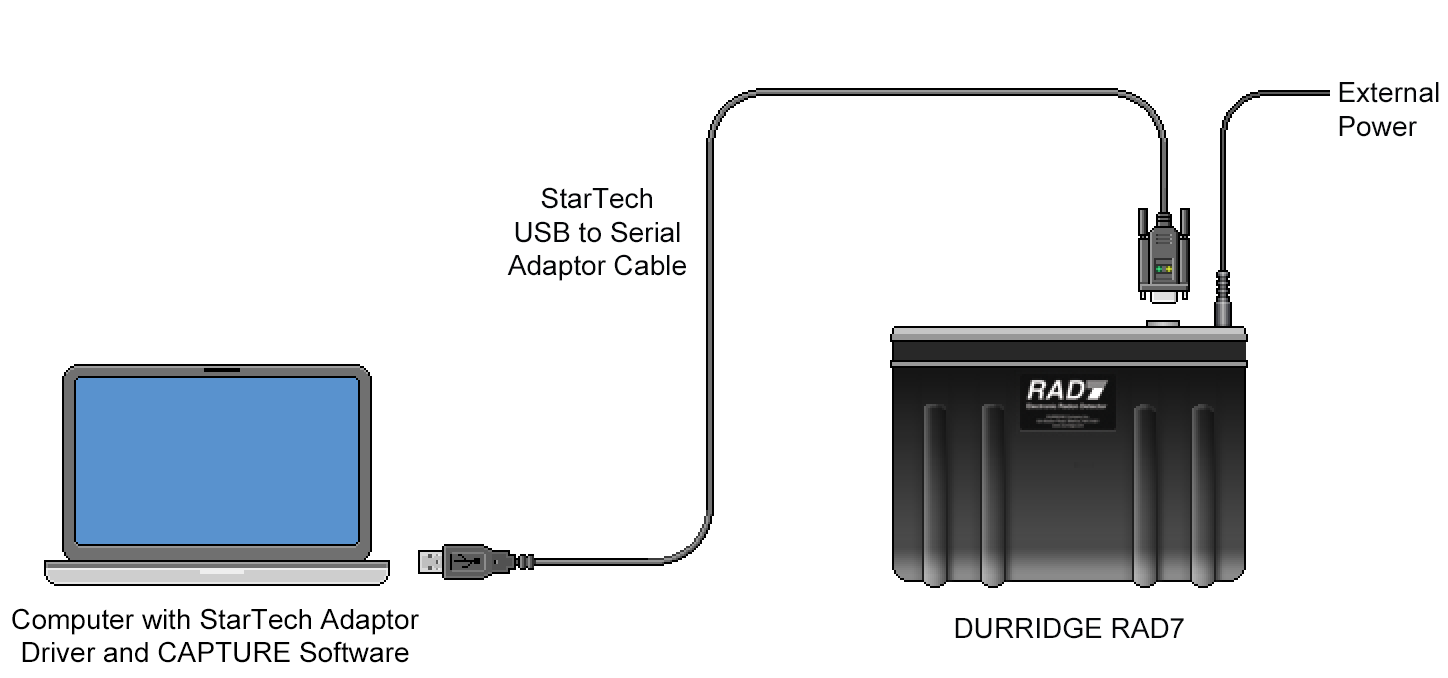
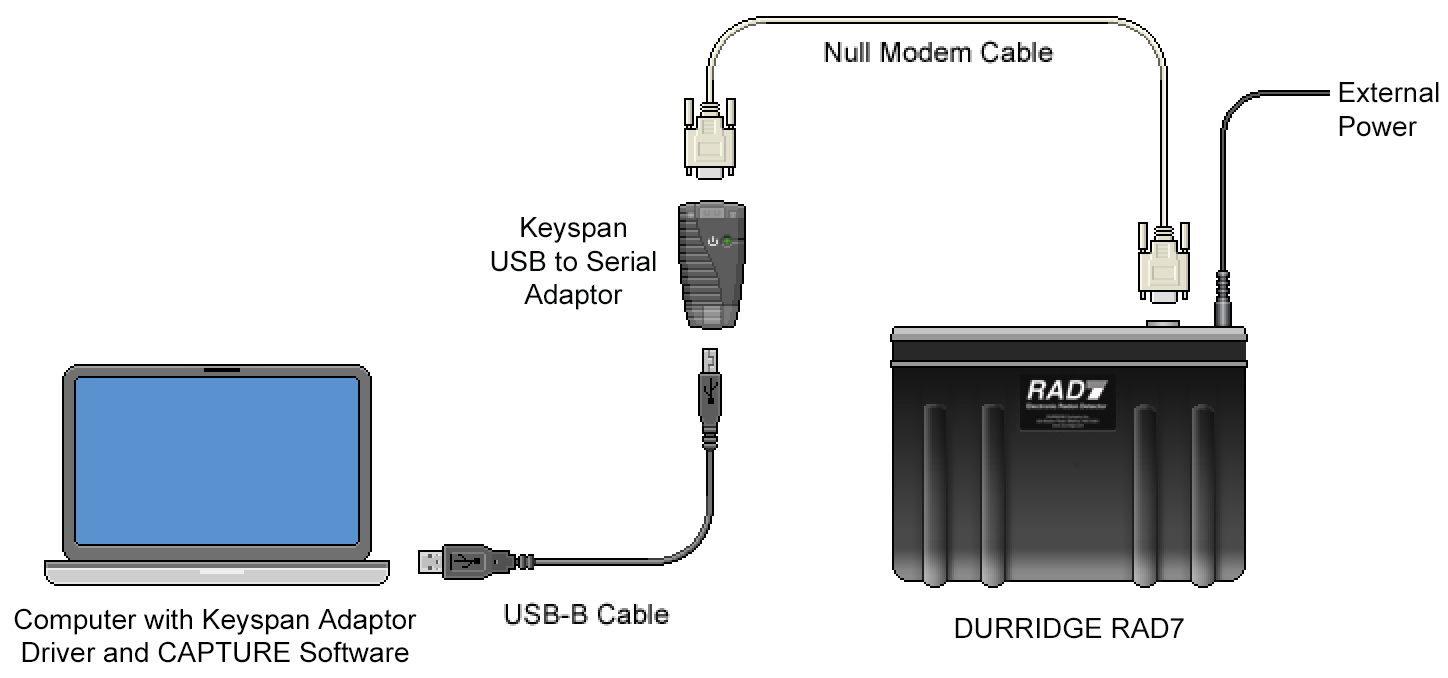
OBTAINING RAD8 AND RAD7 DATA |
|
|
This section will provide instructions on connecting the RAD8 and RAD7 to a computer, using Capture to detect the instrument. It will also cover downloading radon data from the instrument, and displaying the data in a graph. Note that Capture 8 Pro customers are eligible to sign up for Capture Cloud, which allows a RAD8 connected to Wi-Fi to automatically upload radon test data to a cloud-based server administered by Durridge. The data immediately becomes available from within Capture, without the need to physically connect the RAD8 to a computer. For details, please see the Capture Cloud section. |
|
RAD8 Setup Make sure the RAD8 contains valid tests, and that it is plugged into a stable power source and powered On. The included USB-A to Mini-B cable should be used to connect the RAD8 to the compter. It may be necessary to install USB to Serial adaptor driver software on your computer. Drivers are available at the Software Drivers page at the Durridge website. The RAD8's built-in Wi-Fi allows it to communcate with Capture without a USB cable. For more information, see the Network and Remote Connectivity section. Figure 1 shows how to connect the RAD8 to a computer using the USB-A to Mini-B Cable. RAD7 Setup Make sure the RAD7 contains valid tests, and that it is plugged into a stable power source and powered On. The included USB to Serial adapter should be connect the instrument to the computer. It may be necessary to install USB to Serial adaptor driver software on your computer. Drivers are available at the Software Drivers page at the Durridge website. If the computer has a physical serial port, it is possible to instead use an RS232 DB9 female to female null modem cable to connect the RAD7 directly to the computer's serial port. For wireless RAD7 connectivity, a Bluetooth Serial adapter may be used to facilitate communication, as explained in the Network and Remote Connectivity section. Durridge offers preconfigured Parani SD-1000 Serial to Bluetooth Adapters as an optional RAD7 accessory. Figures 2 and 3 show how to connect the RAD7 to a computer using two different kinds of USB to Serial adapters: the StarTech adapter (Figure 2), and the Keyspan adapter (Figure 3). |
|
|
|
When Capture starts up, the Main Window will appear. This window contains controls used for downloading radon data from the RAD8 and RAD7, opening existing radon data files from disk, and performing communication operations. When the Main Window first appears, some controls will be disabled. These controls become active only when a connected instrument has been detected. |
|
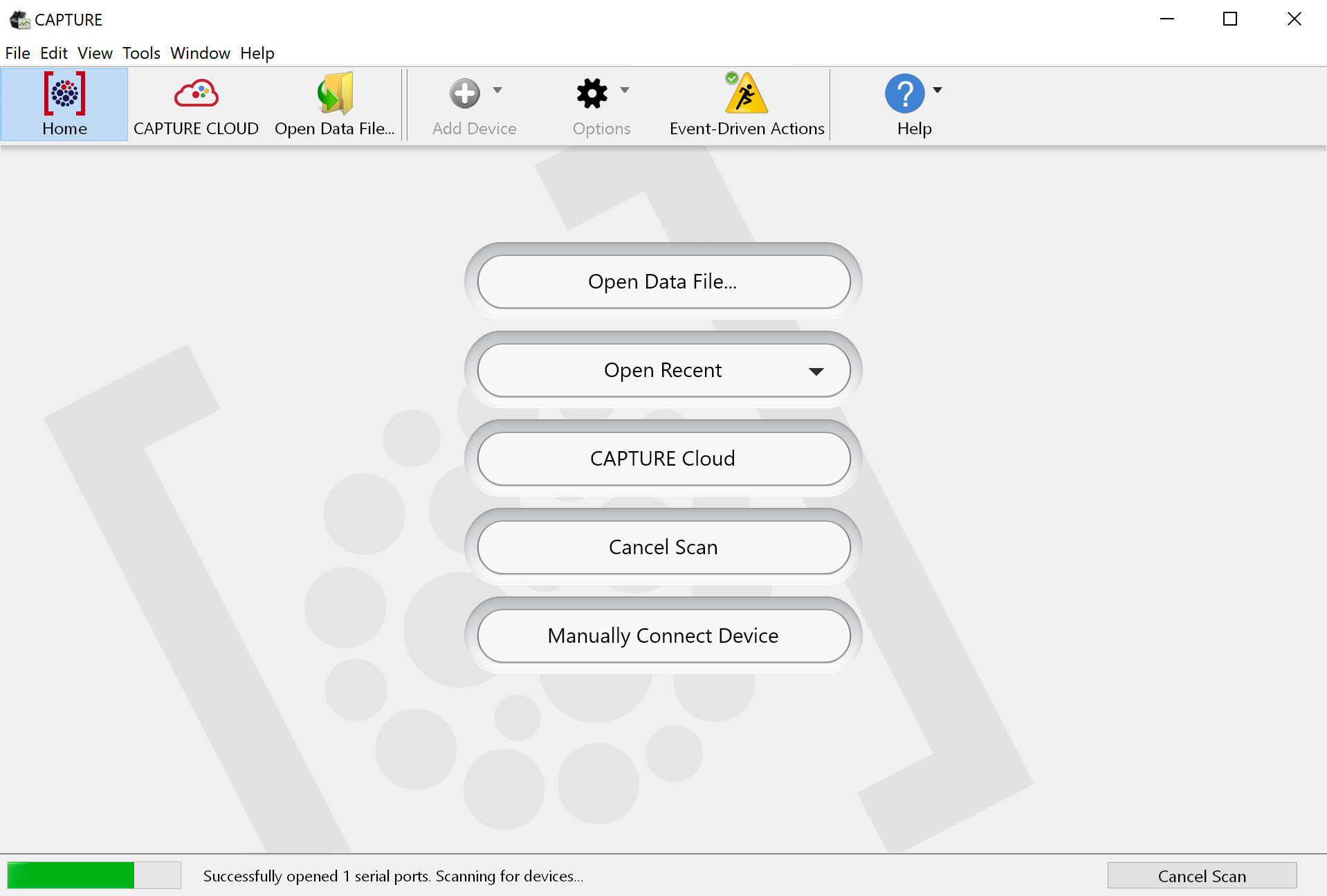
|
When Capture launches, it will automatically detect any connected RAD8s, RAD7s, and DRYSTIKs, as long as automatic device detection can be enabled in Capture's Settings Window. This option is enabled by default. (Note that a RAD7 must contain RADLINK in order for it to be detected.) When an instrument is detected, its icon will appear in the toolbar at the top of the Main Window. Selecting the instrument icon provides access to the device's data and makes it possible to monitor the device's status. If Capture does not automatically detect the connected instrument(s), click the Scan For Devices button at the lower right corner of Capture's Main Window. When Capture is scanning for devices, a progress bar will appear at the bottom of the Main Window, and any detected instruments will be added to the window's toolbar, as shown in Figure 4, above. RADLINK Software for RAD7 Note that Capture can only detect a connected RAD7 if the instrument contains RADLINK software, as indicated by a functioning Special menu on the instrument. When RADLINK is installed, it is possible to obtain data from the RAD7 without having to press any buttons on the instrument itself. If the RAD7 does not have RADLINK installed, or if RADLINK has been damaged, it may still be possible to download data to Capture, by initiating the data transfer from the RAD7 as explaiend below. RADLINK can be reinstalled, if necessary, by following the instructions in the RADLINK Operations section. Alternatively, RADLINK will be installed when the RAD7 is returned to Durridge for calibration. Unlike the RAD7, the RAD8 does not require RADLINK to communicate with a computer. If a RAD7 without RADLINK is connected to the computer, click the Add Device button in the toolbar, which is shown in Figure 5, below, and choose Add RAD7 from the menu that appears. The Connection Panel will appear, containing controls for specifying the Connection Type, Serial Port, and Baud Rate, as shown in Figure 6. The Connection Type pop-up menu should be set to "Serial Port". (The "Network" option is for connecting to a RAD7 at a remote location. This may require some additional configuration, as discussed in the Network and Remote Connectivity section.) The Port pop-up menu should be set to the name of the serial port to which the RAD7 is connected. Finally, the Baud Rate pop-up menu should be set to the baud rate of the RAD7. A RAD7's baud rate is typically 9600, however for a RAD7 without RADLINK, the baud rate will always be 1200. After specifying the Port and Baud Rate settings, click the Connect button. |


|
Note that it is possible to manually connect to a RAD7 even if it has RADLINK installed, however it is more convenient to let Capture detect it automatically using the Scan for Devices button. If RADLINK is installed, the RAD7's baud rate may be checked and altered using the RAD7's keypad. To do this, select the Special menu command on the keypad and press [ENTER], and then navigate to the SetBaud command and press [ENTER] again. Use the left and right arrow keys to choose the desired baud rate, and press [ENTER] once again to confirm the selection. When downloading data manually, whichever baud rate is chosen on the RAD7 must also be chosen in Capture. If RADLINK is not installed, the Special menu commands will be unavailable and therefore the baud rate can not be checked on the RAD7, however it can be assumed to be 1200. |
Downloading a RAD8's contents to your computer makes it possible to graph, analyze, and share the RAD8 data, as well as preserve it against accidental erasure. It is recommended that the data be downloaded upon completion of each on-site test, or as frequently as is practical. Along the left side of Capture's main window is a column of icons for connecting to four panels used for performing common RAD8 communication operations. These include Download RAD8 Data, Chart Recorder, Issue RAD8 Commands, and Relay RAD8 Commands. The Download RAD8 Data panel will be selected by default. Select the Download RAD8 Data panel if it is not already highlighted. The following controls will appear, as shown in Figure 7, below:
|
|
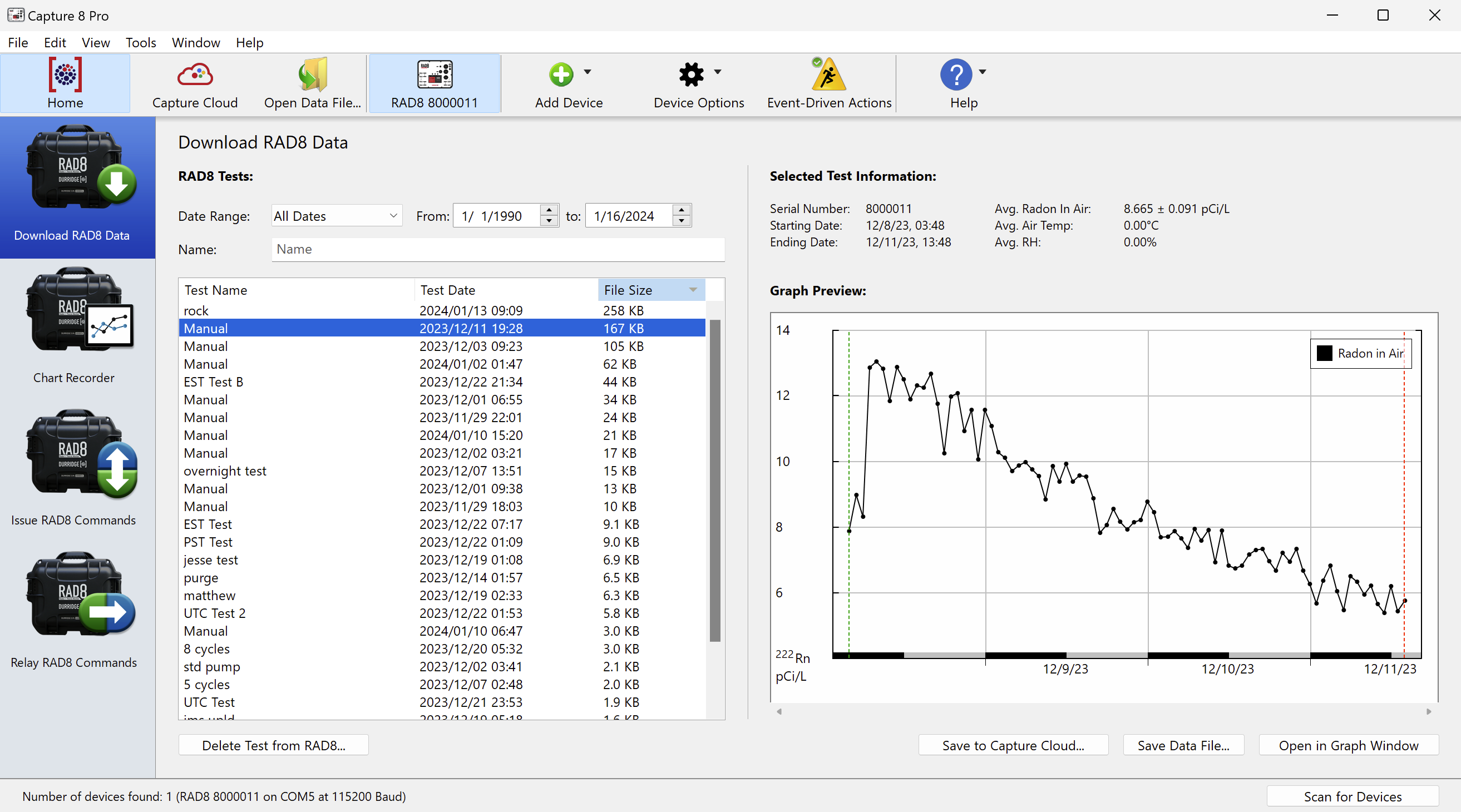
Downloading a RAD7's contents to your computer makes it possible to graph, analyze, and share the RAD7 data, as well as preserve it against accidental erasure or corruption. It is recommended that the data be downloaded upon completion of each on-site test, or as frequently as is practical. Along the left side of Capture's main window is a column of icons for connecting to several panels used for performing common RAD7 communication operations. These include Download RAD7 Data, Chart Recorder, Issue RAD7 Commands, and Relay RAD7 Commands. After Capture has connected to a RAD7, a series of brief tests will be performed to determine which communication operations are possible. The Download RAD7 Data panel is enabled for all RAD7s, and the other panels will be enabled as long as the RAD7 contains RADLINK. Select the Download RAD7 Data panel if it is not already highlighted. The following controls will appear, as shown in Figure 8, below:
If RADLINK software is installed on the RAD7, the downloaded RAD7 data file will contain supplementary information including the RAD7 device identity, thoron data, and run and cycle numbers, and the file name will use the .R7CDT extension. Files lacking this supplementary data use the .R7RAW extension. While R7CDT files are somewhat larger on disk than R7RAW files, both are quite compact and storage requirements should not be a concern. Be aware that if the Include RAD7 Spectrum Data checkbox is checked, the resulting RAD7 data file will use a sophisticated text-based format that that does not resemble the RAD7's raw output. If the Include RAD7 Spectrum Data checkbox is not checked, the data file will use a simple format consisting of the RAD7's unaltered responses to the basic data download commands. The latter format is easier to read in a text editor such as Notepad for Windows or TextEdit for macOS. |
|
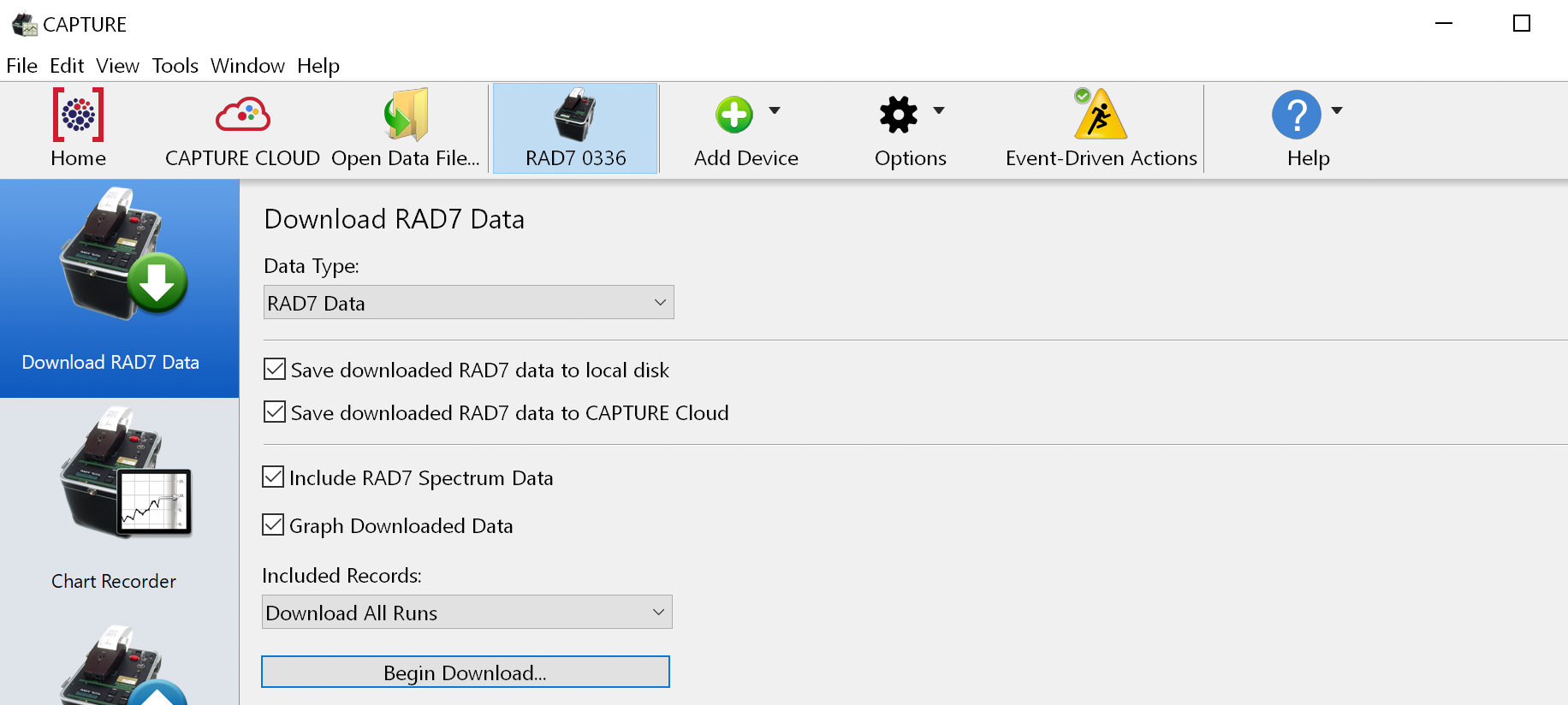
|
After specifying the appropriate download parameters, click the Begin Download button. You will be prompted to specify a name and location for the downloaded RAD7 data file. If the RAD7 has RADLINK, data will begin arriving almost immediately, as shown in Figure 9, below. Otherwise it will be necessary to start the RAD7 manually. To start the RAD7 manually, use the RAD7 keypad to choose Data, and then Com. Then key in the desired run number and press [ENTER]. You will have sixty seconds to complete this procedure before Capture aborts the download due to an absence of incoming data. The download may be canceled at any point using the Cancel Download button. |
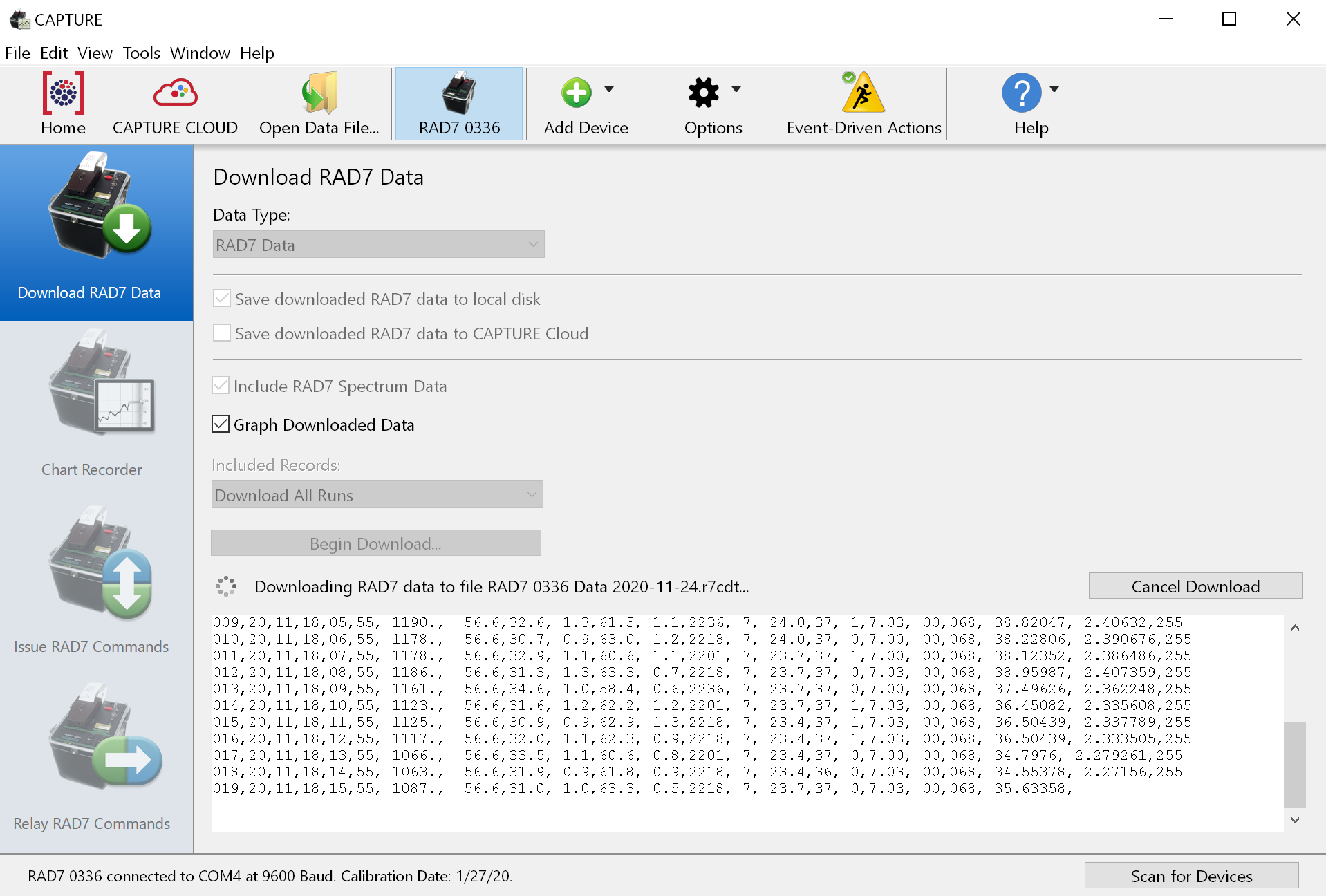
|
As data records are received, they will fill a text area at the bottom of the window as shown in Figure 9. When the data retrieval process is complete, the acquired data will be saved to the specified location on disk and/or to Capture Cloud. If the Graph Downloaded Data checkbox is checked, a Graph Window will appear, and it will display the acquired data as shown in Figure 10, below. |
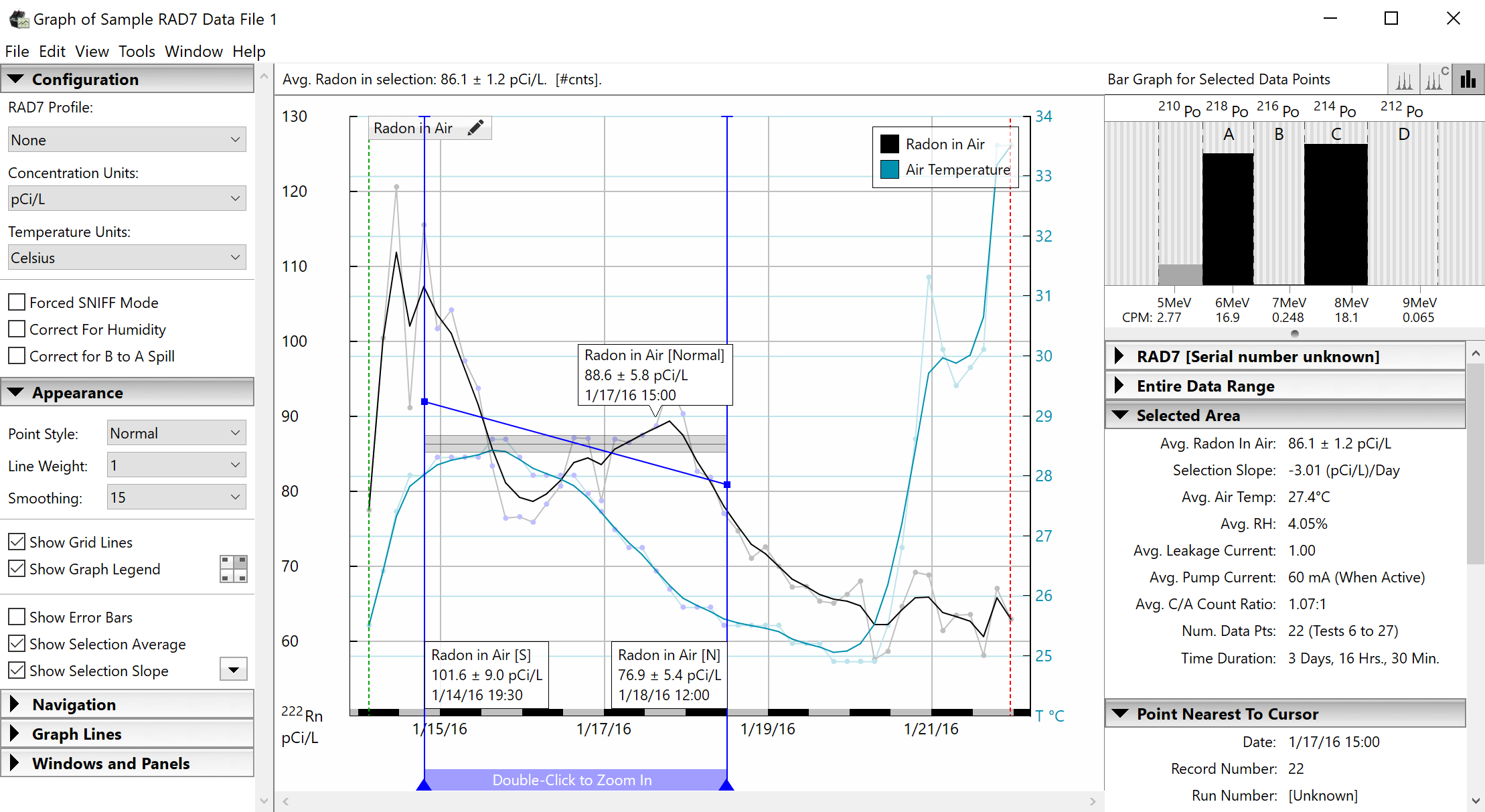
The Graph Window displays radon concentration data across a timeline, with higher radon concentrations plotted higher on the graph image. In addition to radon, a graph may display thoron, temperature, and humidity data.
A multitude of controls are available for navigating RAD8 and RAD7 data graphs, as discussed in the Graph Window Navigation section. Graph data can be configured to reflect particular radon test protocols involving radon-in-water accessories; this is discussed in the Setting Test Parameters section. Graph data and graph images can be exported and printed for use in spreadsheets and presentations using the Export commands in the File Menu. For more details, please see the Data Export, Reports, and Printing section. |
|
|
When the Graph Window opens, it may be necessary to specify certain parameters which affect the interpretation of the data. For RAD8 data these are referred to as the Test Parameters, and for RAD7 data these are referred to as the Run Parameters. For most projects it will be appropriate to leave these parameters at their default settings, but if the radon data was collected with the use of certain Durridge accessories such as the RAD AQUA, Water Probe, or Big Bottle System, then some configuration will be required. This is done using the Test Parameters Window (for RAD8 data) or the Run Parameters Window (for RAD7 data). Please see the Setting Test Parameters Section for more details. |
Capture makes it easy to quickly download all of the data from each connected RAD7. Once the RAD7s have been discovered, the Download Data From All RAD7s command will become enabled in the Options menu located on the Main Window toolbar. |
|
|
 Figure 11: Downloading data from all connected RAD7s.
Figure 11: Downloading data from all connected RAD7s. |